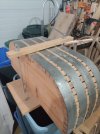patrick corry
solo canoeist
I have a traditional building form for a wood/canvas canoe onto which I will shortly begin bending ribs. The form is of unknown age, though relatively new, presumably 10 years old or so. The 3/4" x 3/4" strips with which the form was built have dried over time leaving the galvanized metal strips ever so slightly loose, or away, from the body of the form. Those galvanized strips were, of course, fastened at the center line and near the inwale position and since they haven't changed length they now stand a bit proud of the form surface.
Should I release the strips at the inwale end and re-fasten so they are tight to the form? And also, after removing (sanding off) the surface corrosion, should I varnish the entire form to inhibit future corrosion? I'm concerned a bit with having the few spots of rust transfer to the ribs which will be hot & moist when in contact with the metal.
Thanks for your thoughts.
Should I release the strips at the inwale end and re-fasten so they are tight to the form? And also, after removing (sanding off) the surface corrosion, should I varnish the entire form to inhibit future corrosion? I'm concerned a bit with having the few spots of rust transfer to the ribs which will be hot & moist when in contact with the metal.
Thanks for your thoughts.
Last edited:

